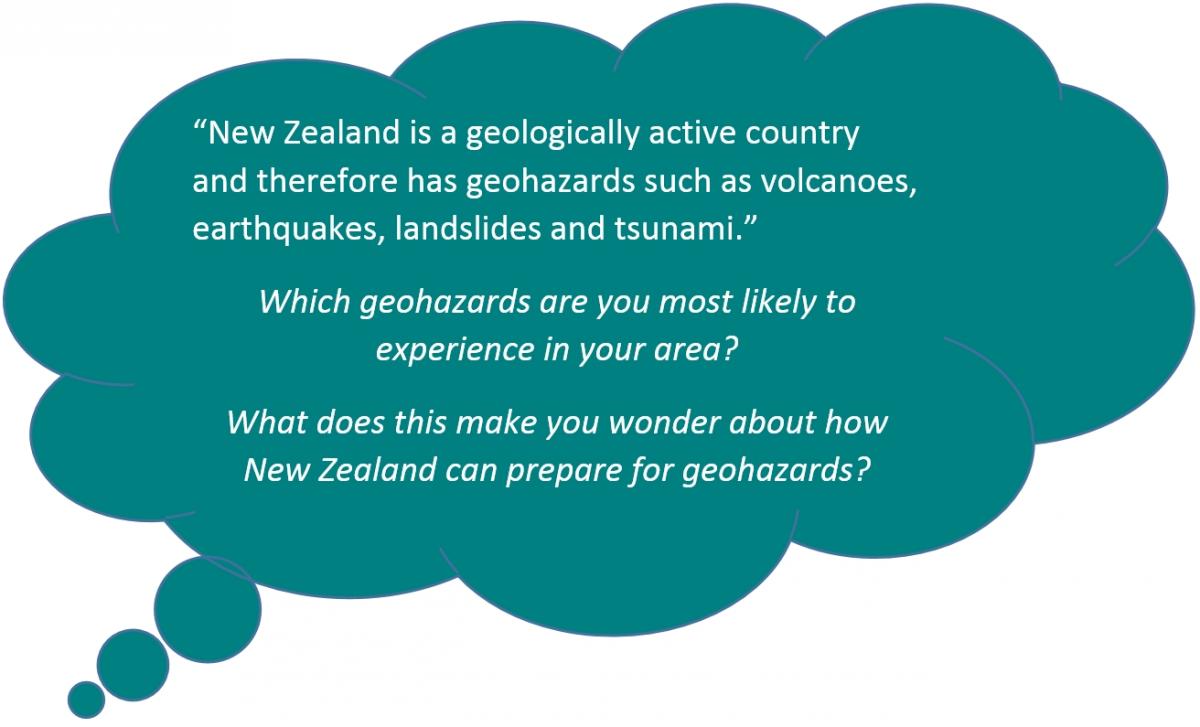The word geohazard comes from two words:
- Geo – from the word ‘geological’ meaning from the earth.
- Hazard – something that poses a risk to people, places and property.
So ‘geohazards’ means the risk of damage from a geological process.
Sometimes hazards are not easy to see. All geological hazards (geohazards) could be called dormant until they are triggered.
The study and monitoring of geohazards helps us to better prepare ourselves and helps us respond to these geological events when they do occur.
Types of geohazard
landslidesGeohazards include:
- earthquakes
- tsunami
- volcanoes
- lahars
- hydrothermal eruptions
Common geohazards in New Zealand
New Zealand is geologically active. This is because it sits across the boundary between two tectonic plates. These moving plates create huge forces that have shaped our amazing land; pushing up mountains, carving out lakes and rivers and creating our rugged coastline. These forces are still shaping the land today and can also cause frequent earthquakes, landslides, volcanic eruptions, hydrothermal activity and even tsunami.
Earthquakes

Earthquakes are caused when rocks break due to the stress of the moving tectonic plates. Large earthquakes near towns or cities can cause great damage and sometimes loss of life. For this reason it is important for New Zealanders to know how to prepare for earthquakes.
Tsunami
A tsunami is a series of powerful ocean surges caused by movement of part of the sea floor – often by an undersea earthquake or landslide. Most tsunamis are like very strong, fast tides, rather than waves. The larger ones can travel a long way inland. Much of the damage from tsunami is caused by the debris carried in the water.
Volcanoes
When magma reaches the earth’s surface a volcano is formed. When a volcano erupts it shoots out pieces of rock and magma (ash) along with steam and gases. New Zealand’s volcanoes are often active and are always monitored, for example Ruapehu, Tongariro and White Island. Ash from eruptions can spread over large distances so can affect people living a long way from the eruption. Hazards can also happen close to active volcanic vents.
Lahars
A lahar is a volcanic mudflow. When moving, a lahar looks like a mass of wet concrete carrying pieces of rock. Lahars can be different sizes and move at different speeds. Lahars can cause widespread damage.
Eruptions may start lahars by quickly melting snow and ice on a volcano, or moving water from a crater lake. Lahars can also be formed by heavy rainfall during or after an eruption, which washes volcanic ash off the volcano. Some of the largest lahars begin as landslides.
Hydrothermal activity
Hydrothermal systems are found where there is volcanic activity. The heat from the volcanic activity heats the local ground water. Most of New Zealand’s hydrothermal activity is found in the Taupō Volcanic Zone.
Hydrothermal activity includes:
- hot springs
- geysers
- warm ground.
Ground can become unstable in these areas and dangerous gases can form. Eruptions of hot water can also occur.
Landslides
A landslide is a movement of soil and rock down a slope. Landslides often happen because of earthquakes, volcanic eruptions and floods (rainfall).
Landslides are common in New Zealand. Large landslides in towns and cities can cause thousands of dollars in damage and can be a risk to people.











